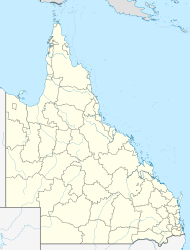Cape Palmerston National Park: Difference between revisions
No edit summary |
No edit summary |
||
| Line 33: | Line 33: | ||
It contains a land area of 7,160 ha and has 28 km of coastline on each side of the Cape Palmerston—named by [[Captain James Cook]] in 1770 after [[Henry Temple, 2nd Viscount Palmerston|Viscount Palmerston]], a [[List of Lords Commissioners of the Admiralty|Lord Commissioner of the Admiralty]].<ref name="Beaglehole"/> Within the park is the 344 m Mount Funnel.<ref name="Short2000"/> |
It contains a land area of 7,160 ha and has 28 km of coastline on each side of the Cape Palmerston—named by [[Captain James Cook]] in 1770 after [[Henry Temple, 2nd Viscount Palmerston|Viscount Palmerston]], a [[List of Lords Commissioners of the Admiralty|Lord Commissioner of the Admiralty]].<ref name="Beaglehole"/> Within the park is the 344 m Mount Funnel.<ref name="Short2000"/> |
||
{{external media |video1=[https://www.youtube.com/watch?v=gz5MP6g4qTE Aerial view of Cape Creek Camping Ground] }} |
{{external media |video1=[https://www.youtube.com/watch?v=gz5MP6g4qTE Aerial view of Cape Creek Camping Ground] }} |
||
The park contains [[Mangrove|mangrove trees]], [[Dune|dunes]], [[Woodland|woodlands]], [[Poaceae|grass]], and [[Wetland|wetlands]]. It is home to the threatened [[False water rat|water mouse]] species, and hosts numerous birds. Three other rare or threatened species have been identified in the park.<ref name="wetlandinfo"/> Birdwatching enthusiasts can enjoy the view of ospreys and sea eagles hovering over their heads, and white-breasted woodswallows in flowering grasstrees.<ref>https://www.queensland.com/us/en/things-to-do/attractions/p-56b25e9a2cbcbe7073ad8291-cape-palmerston-national-park</ref> |
The park contains [[Mangrove|mangrove trees]], [[Dune|dunes]], [[Woodland|woodlands]], [[Poaceae|grass]], and [[Wetland|wetlands]]. It is home to the threatened [[False water rat|water mouse]] species, and hosts numerous birds. Three other rare or threatened species have been identified in the park.<ref name="wetlandinfo"/> Birdwatching enthusiasts can enjoy the view of ospreys and sea eagles hovering over their heads, and white-breasted woodswallows in flowering grasstrees.<ref>{{Cite web|title=Cape Palmerston National Park - Attractions|url=https://www.queensland.com/us/en/things-to-do/attractions/p-56b25e9a2cbcbe7073ad8291-cape-palmerston-national-park}}</ref> |
||
Access is by [[four-wheel drive]] vehicle.<ref name="nprsr"/> There are three camping areas. Permits are required and can be collected at a self-registration station. |
Access is by [[four-wheel drive]] vehicle.<ref name="nprsr"/> There are three camping areas. Permits are required and can be collected at a self-registration station. |
||
Revision as of 05:01, 19 February 2022
| Cape Palmerston National Park Queensland | |
|---|---|
| Nearest town or city | Koumala |
| Coordinates | 21°35′25″S 149°25′39″E / 21.59028°S 149.42750°E |
| Established | 1976 |
| Area | 71.9 km2 (27.76 sq mi)[1] |
| Managing authorities | Queensland Parks and Wildlife Service |
| Website | Cape Palmerston National Park |
| See also | Protected areas of Queensland |
Cape Palmerston is a national park in the Mackay Region, Queensland, Australia.[2]
Geography
The park is 748 km northwest of Brisbane. It is located within the boundaries of Koumala, part of the Mackay Region local government area. It lies within the water catchment area of Plane Creek and the Central Mackay Coast bioregion.[1]
It contains a land area of 7,160 ha and has 28 km of coastline on each side of the Cape Palmerston—named by Captain James Cook in 1770 after Viscount Palmerston, a Lord Commissioner of the Admiralty.[3] Within the park is the 344 m Mount Funnel.[4]
| External videos | |
|---|---|
The park contains mangrove trees, dunes, woodlands, grass, and wetlands. It is home to the threatened water mouse species, and hosts numerous birds. Three other rare or threatened species have been identified in the park.[1] Birdwatching enthusiasts can enjoy the view of ospreys and sea eagles hovering over their heads, and white-breasted woodswallows in flowering grasstrees.[5]
Access is by four-wheel drive vehicle.[6] There are three camping areas. Permits are required and can be collected at a self-registration station.
See also
References
- ^ a b c "Cape Palmerston National Park". WetlandInfo. Department of Environment and Heritage Protection. Retrieved 11 May 2015.
- ^ "Cape Palmerston National Park – Mackay Region (entry 6129)". Queensland Place Names. Queensland Government. Retrieved 29 June 2017.
- ^ Beaglehole, J.C., ed. (1968). The Journals of Captain James Cook on His Voyages of Discovery, vol. I:The Voyage of the Endeavour 1768–1771. Cambridge University Press. pp. 334–335. OCLC 223185477.
- ^ Short, Andrew (2000), Beaches of the Queensland Coast: Cooktown to Coolangatta, Sydney University Press, p. 202, ISBN 0958650411.
- ^ "Cape Palmerston National Park - Attractions".
- ^ Cape Palmerston National Park, Queensland Government: Department of National Parks, Recreation, Sport and Racing, 15 February 2012, retrieved 14 February 2013.

